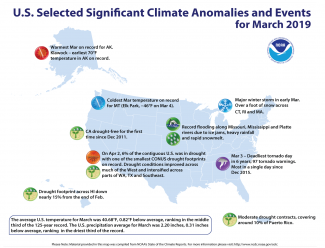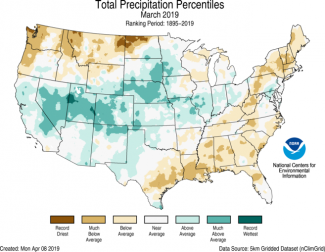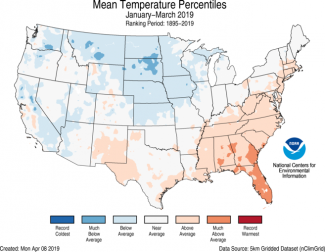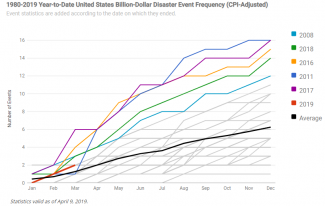U.S. impacted by 2 billion-dollar disasters in first 3 months of 2019
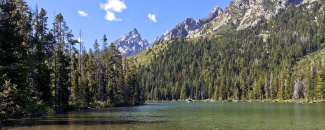
In the first three months of 2019, there were two weather and climate disaster events with losses exceeding $1 billion each across the U.S. These events included a severe storm event across the Southeast, Ohio Valley and Northeast, and one flooding event in the central U.S., which is still ongoing.
During March, the average contiguous U.S. temperature was 40.68°F, 0.82°F below the 20th-century average. This ranked in the middle third of the 125-year period of record. The year-to-date (January–March) average contiguous U.S. temperature was 35.03°F, 0.12°F below average, ranking among the middle third of the record. This was the coldest start to a year since 2014. The March precipitation total for the contiguous U.S. was 2.20 inches, 0.31 inch below average, and ranked in the driest third of the 125-year period of record. The year-to-date precipitation total was 8.03 inches, 1.07 inch above average, tying with 1949 as the 12th wettest January–March period on record.
This monthly summary from NOAA National Centers for Environmental Information is part of the suite of climate services NOAA provides to government, business, academia and the public to support informed decision-making.
March Temperature
-
Below-average temperatures were observed in the Northwest, the Great Plains and across portions of the Mississippi and Ohio River valleys. A small pocket of record-cold temperatures was evident across a portion of Washington state.
-
Arizona and New Mexico had above-average temperatures during March, while most of the contiguous U.S. experienced near-average temperatures for the month.
-
The Alaska March temperature was 26.7°F, 15.9°F above the long-term average. This was the warmest March in the 95-year period of record for the state and exceeded the previous warmest March in 1965 by more than 3°F. All long-term climate stations north of the Alaska Range and Bristol Bay had their warmest March on record. Kotzebue’s average March temperature was warm enough to be among its 10 warmest Aprils on record.
March Precipitation
-
During mid-March, a “bomb cyclone” developed across the central U.S. bringing snow, blizzard conditions, heavy rainfall and above-freezing temperatures across parts of the interior U.S., which already had significant snowpack on the ground. This resulted in widespread flash flooding due to the combination of new rainfall, rapidly melting snow and frozen ground. A State of Emergency was declared for parts of Nebraska, Iowa, South Dakota and Wisconsin as the Missouri, Platte and Mississippi rivers breached their banks.
-
Above-average precipitation was observed across parts of the West, central Rockies and into the central Plains and middle Mississippi Valley. This precipitation exacerbated the flooding that occurred during the latter half of March in the central U.S. Flooding along these major rivers and tributaries is anticipated to continue well into April.
-
Below-average precipitation was observed across the Northwest, South, Southeast and East Coast. Washington and Montana had one of their 10 driest Marchs on record.
-
According to the April 2 U.S. Drought Monitor report, 6 percent of the contiguous U.S. was in drought, down from 12 percent at the end of February and is one of the smallest contiguous U.S. drought footprints on record. Drought conditions continued to improve across much of the West and intensified across parts of Washington, Texas and the Southeast.
January–March (Year-to-Date) Temperature
-
Above-average temperatures were primarily observed across the Southeast and Atlantic Coast. Florida had an average January–March temperature that ranked among its 10 warmest on record. Near-average conditions stretched from the southern Plains to the Northeast and across much of the West. Below-average temperatures were present across the northern and central Plains and parts of the West.
-
The Alaska January–March temperature was 16.6°F, 10.7°F above the long-term average, the third warmest on record for the state. Record temperatures were observed across most of the state with much-above-average temperatures occurring across the Aleutians and the panhandle.
January–March (Year-to-Date) Precipitation
-
Below-average precipitation was observed across the South and parts of the Southeast. Washington ranked 10th driest for the year-to-date period. Above-average precipitation stretched from coast-to-coast with many states having one of their 10 wettest January–March periods on record; Colorado was fourth wettest, Tennessee and Utah were fifth wettest and Nevada sixth wettest.
Billion Dollar Weather and Climate Disasters
-
In February 2019, widespread damage resulted from severe weather and flooding in the South (MS, AL, TN) and high winds across Ohio Valley (IL, IN, OH) and Northeastern states (CT, MD, MA, NJ, NY, PA, VA, WV).
-
Historic Midwest flooding, which began in March and is currently ongoing, inundated millions of acres of agriculture, numerous cities and towns and caused widespread damage to roads, bridges, levees and dams. The states most affected include Nebraska, Iowa, Missouri, South Dakota, Minnesota and Wisconsin.
-
In April 2019, NCEI added three historical weather and climate events. The U.S. has now sustained 246 weather and climate disasters since 1980 where overall damages/costs reached or exceeded $1 billion (based on Consumer Price Index adjustment to 2019). The total cost of these 246 events exceeds $1.6 trillion.

